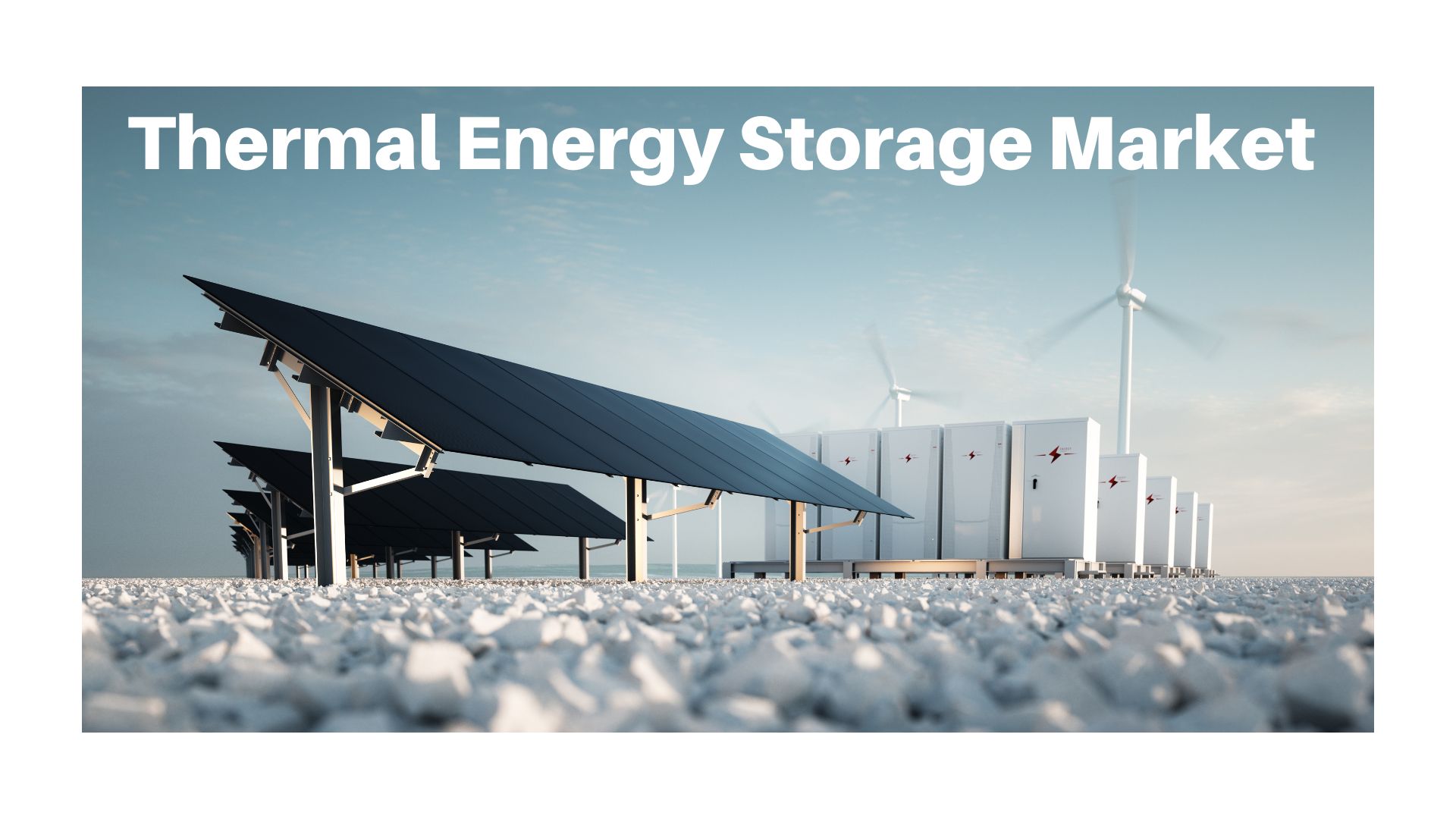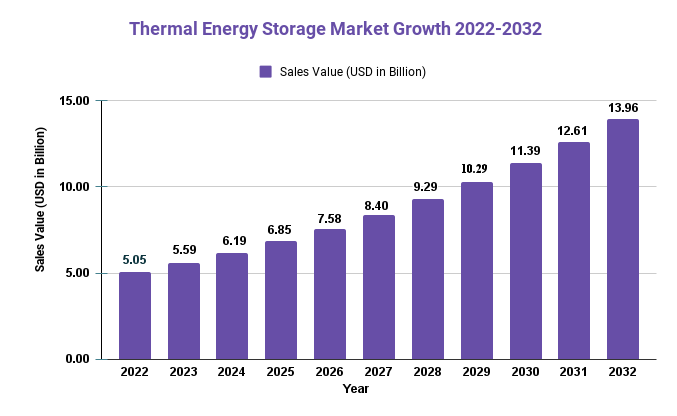Thermal Energy Storage Market Size Expected Reach 13.96 Bn By 2032

Page Contents
Market Overview
Published Via 11Press: In 2022, the global thermal energy storage market size was valued at USD 5.05 billion and is projected to expand at a compound annual growth rate (CAGR) of 10.7% between 2022 and 2032.
Thermal energy storage (TES) is a technology that enables excess thermal energy to be stored and used at another time.
The growing demand for renewable energy sources, such as solar and wind power, is fueling growth in the thermal energy storage market. TES systems store excess energy generated from these renewable resources so they can be used when demand is high or other renewable resources are unavailable.
Request For Sample Report Here: https://market.us/report/thermal-energy-storage-market/request-sample

Regional Snapshot
- North America: The North American market for TES systems is being driven by government incentives and regulations to reduce carbon emissions. The United States leads the region, with California seeing significant growth opportunities due to renewable energy targets driving demand for TES systems there. Canada too plays a significant role in this space with their government providing incentives for the adoption of sustainable energy sources.
- Europe: The European TES market is driven by an increasing need for renewable energy sources and the need to reduce carbon emissions. Germany leads the region in terms of market share due to their ambitious targets for renewable energy adoption. Other important European markets include Spain, France, and the United Kingdom.
- Asia-Pacific: The Asia-Pacific region is the largest and fastest-growing market for TES products. This growth is being spurred by rising demand for renewable energy sources, especially in China and India where solar power adoption is on the rise. Japan and South Korea have also emerged as significant markets due to government incentives and regulations designed to reduce carbon emissions.
- Middle East & Africa: The Middle East & Africa market for TES is driven by growing demand for renewable energies and the need to reduce reliance upon fossil fuels. Because of the significant investment made in renewable energy sources, especially solar power, the United Arab Emirates, is the largest market within the region. South Africa, Morocco, and other important markets are also available in the region.
- South America: South America is driven by the need to reduce dependence on fossil fuels, and the growing demand to use renewable energy sources. Brazil is the biggest market in the region because of its large investment in renewable energy resources, especially solar and wind power. Chile and Argentina are other important markets in this region.
Drivers
- Increased Demand for Renewable Energy Sources: Globally, there is an increasing interest in renewable energy sources like solar and wind power. TES systems enable storage of this excess energy produced by these renewable sources so it can be used when demand for electricity spikes or there are no available renewable resources.
- Focusing on Energy Efficiency: TES systems can enhance energy systems' efficiency by storing excess power during off-peak hours and using it during peak usage times. This helps reduce energy costs and carbon emissions.
- Government Support and Incentives: Governments around the world are offering financial assistance and incentives for the adoption of TES systems, particularly in regions where renewable energy targets are being implemented.
- Globalizing Air Conditioning Demand: As temperatures rise and urbanization increases, the need for air conditioning increases. Thermal energy storage systems such as TES can be employed to store excess thermal energy during off-peak hours and release it during peak usage periods – helping reduce energy costs and carbon emissions simultaneously.
- Need for Reliable and Resilient Energy Systems: TES systems can enhance energy system stability and resilience by providing backup power during power outages, thus decreasing the risk of blackouts.
- Technological Developments: The introduction of cutting-edge TES technologies such as phase change materials and advanced adiabatic compressed air energy storage is propelling the growth of the TES market.
Restraints
- High Initial Costs: The costs associated with installing TES systems can be prohibitively expensive, discouraging some potential users from investing in these solutions.
- Lack of Awareness and Understanding: Lack of awareness and comprehension about TES systems could potentially thwart their adoption. Users may not be informed about the advantages associated with these solutions, leading to reluctance to invest in them.
- Regulatory and Policy Challenges: The absence of regulatory and policy support for TES systems could hinder their growth. Governments may not offer sufficient incentives for their adoption, discouraging potential users from investing in them.
- Lack of Scalability: Some TES systems may not be capable of scaling, which could limit their use in certain applications. For instance, some may only be suitable for residential or small commercial needs but not large industrial or utility-scale needs.
- Technological Limitations: The current state of technology may constrain TES systems' performance, such as their energy storage capacity or resistance to harsh environmental elements.
- Competition from Alternative Energy Storage Technologies: TES systems may face competition from alternative energy storage technologies such as batteries, which may offer lower initial costs and be more familiar to potential users.
Opportunities
- Growing demand for renewable energy: With the ever-increasing popularity of renewable sources, there will be an ever-increasing need for energy storage systems that can store the excess output. TES systems offer the perfect solution, offering both flexibility and scalability in storage solutions.
- Advances in Technology: There is significant potential for technological advances within TES systems, which could result in improved performance, greater energy storage capacity, and lower costs. For instance, phase change materials developed recently could enhance TES system efficiency and effectiveness.
- Energy Demand Increase: As global energy consumption continues to increase, there will be an ever-increasing need for energy storage solutions that can meet this demand. TES systems offer a reliable and flexible energy storage solution that helps reduce energy costs and carbon emissions.
- Focus on Energy Efficiency: With an ever-increasing emphasis on energy efficiency and carbon emissions, there will be an ever-increasing need for energy storage systems that can reduce costs while improving system performance. TES systems offer a solution that helps meet these objectives.
- Government Support and Incentives: Governments around the world are offering financial incentives to encourage the adoption of TES systems, particularly in regions with ambitious renewable energy targets. This support can create an encouraging atmosphere for growth in this market.
- Global Growing Demand for Air Conditioning: As temperatures rise and urbanization increases, the need for air conditioning grows. Thermal energy storage (TES) systems can be employed to store excess thermal energy during off-peak hours and release it during peak usage times, helping reduce energy costs and carbon emissions.
View Detailed TOC of the Report | https://market.us/report/thermal-energy-storage-market/table-of-content/
Challenges
- High Initial Costs: The costs associated with installing TES systems can be substantial, which may deter potential users from adopting them.
- Limited Scalability: Some TES systems may not be capable of scaling, which could restrict their use in certain applications. For instance, some may only be suitable for residential or small commercial purposes but not large industrial or utility-scale tasks.
- Lack of Standardization: Lack of standardization in the TES industry makes it difficult for prospective users to compare different TES systems and make informed decisions about which system they should choose.
- Technological Limitations: The current state of technology may limit the performance of TES systems, such as their energy storage capacity or resilience in harsh environmental conditions.
- Competition from Alternative Energy Storage Technologies: TES systems may face competition from alternative energy storage technologies such as batteries, which may offer lower initial costs and be more familiar to potential users.
- Regulatory and Policy Challenges: The absence of regulatory and policy support for TES systems could limit their expansion. Governments may not offer enough incentives to encourage the adoption of these technologies, discouraging potential investors from investing in them.
- Limited Awareness and Understanding: Lack of awareness and comprehension about TES systems could hinder their adoption. Users may not be knowledgeable about their advantages, leading to reluctance to invest in them.
Key Market Segments
Type
- Water
- Molten Salt
- Phase Change Material
Application
- Residential
- Commercial & Industrial
Key Market Players
- CALMAC
- ABENGOA SOLAR
- CALDWELL ENERGY
- BALTIMORE AIRCOIL COMPANY
- CHICAGO BRIDGE & IRON
- BRIGHTSOURCE ENERGY
- DC PRO ENGINEERING
- EVAPCO
- DN TANKS
- BURNS & MCDONNELL
Report Scope
| Report Attribute | Details |
| The market size value in 2022 | USD 5.05 Bn |
| Revenue forecast by 2032 | USD 13.96 Bn |
| Growth Rate | CAGR Of 10.7% |
| Regions Covered | North America, Europe, Asia Pacific, Latin America, and Middle East & Africa, and Rest of the World |
| Historical Years | 2017-2022 |
| Base Year | 2022 |
| Estimated Year | 2023 |
| Short-Term Projection Year | 2028 |
| Long-Term Projected Year | 2032 |
Frequently Asked Question
Q: What is the current market size for the Thermal Energy Storage market?
A: According to a report by Market.us, the Thermal Energy Storage market was valued at USD 5.05 billion in 2022 and is expected to reach USD 13.96 billion by 2032, growing at a CAGR of 10.7% during the forecast period.
Q: What are the key segments of the Thermal Energy Storage market?
A: The Thermal Energy Storage market can be segmented based on Type (Water, Molten Salt, Phase Change Material), By Application (Residential, Commercial & Industrial), and geography (North America, Europe, Asia-Pacific, Latin America, and Middle East & Africa).
Q: Who are the key players in the Thermal Energy Storage market?
A: Some of the key players in the Thermal Energy Storage market include CALMAC, ABENGOA SOLAR, CALDWELL ENERGY, BALTIMORE AIRCOIL COMPANY, CHICAGO BRIDGE & IRON, BRIGHTSOURCE ENERGY, DC PRO ENGINEERING, EVAPCO, DN TANKS, BURNS & MCDONNELL.
The team behind market.us, marketresearch.biz, market.biz and more. Our purpose is to keep our customers ahead of the game with regard to the markets. They may fluctuate up or down, but we will help you to stay ahead of the curve in these market fluctuations. Our consistent growth and ability to deliver in-depth analyses and market insight has engaged genuine market players. They have faith in us to offer the data and information they require to make balanced and decisive marketing decisions.



